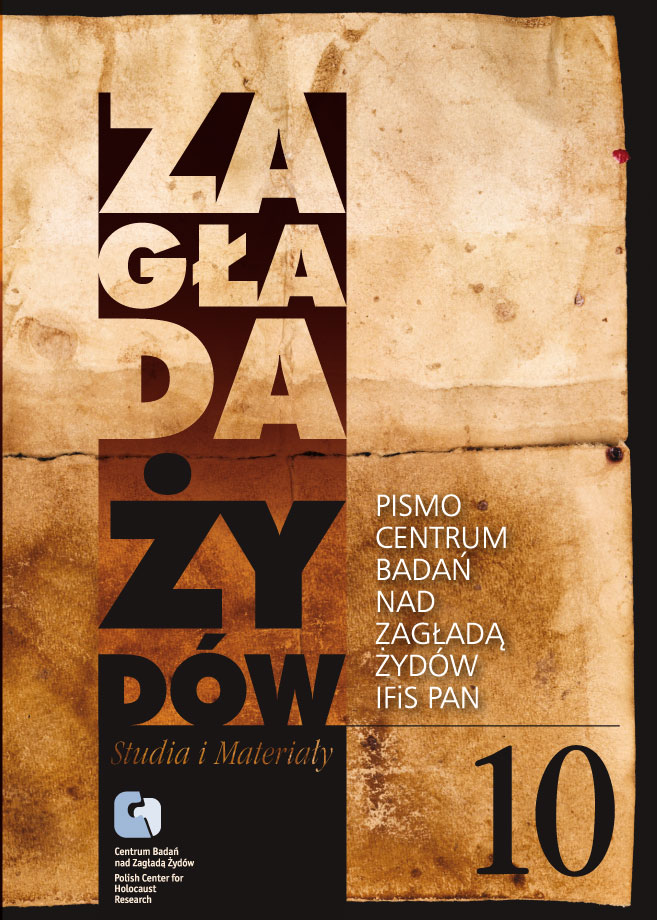Józef Kermisz (1907–2005) – twórca badań nad Szoa
Zagłada Żydów. Studia i Materiały, Nr 10 (2014), Strony: 304-316
Data zgłoszenia: 2020-10-22Data publikacji: 2014-12-01
 https://doi.org/10.32927/ZZSiM.526
https://doi.org/10.32927/ZZSiM.526
Abstrakt
Józef Kermisz (1907–2005) was a historian and an archivist who helped lay the foundations for Shoah research in Poland and Israel. In 1944 joined the Central Jewish Historical Commission where became the chief archivist. Since then his life has been devoted to retrieving wartime archival material. As archive director (in the Jewish Historical Institute in Poland and at Yad Vashem in Israel) he sought to develop an archive both for future historical research and for trials of suspected war criminal. He played a major role in discovering and preserving important documentation on the Shoah in Poland. Among his major professional achievements were preparing documentation for the prosecution in the Eichmann trial, and publishing Czerniakow’s diary and the full edition of the underground press of the Warsaw ghetto. He was one of the world’s leading experts on the Ringelblum Archive and other hidden Jewish documentation from the Holocaust. Kermisz left behind a legacy of a vast research infrastructure that he created and that will occupy scholars for generations.
Licencja
Prawa autorskie (c) 2014 Autor&"Zagłada Żydów. Studia i Materiały"

Utwór dostępny jest na licencji Creative Commons Uznanie autorstwa 4.0 Międzynarodowe.
https://creativecommons.org/licenses/by/4.0
Czasopismo publikowane jest w standardzie Diamond Open Access na licencji CC-BY-4.0 Deed - Uznanie autorstwa 4.0 Międzynarodowa - Creative Commons
Inne teksty tego samego autora
- Avner Shalev, Dan Michman, David Silberklang, Ścisła pamięć o Zagładzie w Muzeum Historii Holokaustu w Yad Vashem. Odpowiedź na artykuł Amosa Goldberga , Zagłada Żydów. Studia i Materiały: Nr 7 (2011)
Podobne artykuły
- Adam Puławski, Funkcjonowanie urzędu powierniczego na przykładzie Chełma , Zagłada Żydów. Studia i Materiały: Nr 13 (2017)
- Jan Tomasz Gross, Czy Zagłada jest ich historią, czy naszą? (Plaidoyer w przedmiocie ustanowienia w Polsce miejsca pamięci poświęconego Zagładzie) , Zagłada Żydów. Studia i Materiały: Nr 13 (2017)
- Kinga Piotrkowiak-Junkiert, Wokół "Syna Szawła" , Zagłada Żydów. Studia i Materiały: Nr 12 (2016)
- Robert Kuwałek, Muzeum-Miejsce Pamięci w Bełżcu – w rok po rozpoczęciu działalności , Zagłada Żydów. Studia i Materiały: Nr 1 (2005)
- Redakcja, Od Redakcji , Zagłada Żydów. Studia i Materiały: Nr 12 (2016)
- Christoph Dieckmann, Niemiecka polityka okupacyjna na Litwie w latach 1941–1944. Podsumowanie , Zagłada Żydów. Studia i Materiały: Nr 13 (2017)
- Marta Ciesielska, „Dużo trudu i dużo piękna w życiu internatu”. Z Domu Sierot Janusza Korczaka , Zagłada Żydów. Studia i Materiały: Nr 8 (2012)
- Jan Grabowski, Tadeusz Tomasz Krasnodębski, Policjant konspiratorem. Szesnaście lat na muszce Gestapo i bezpieki [Policeman-Conspirator. Sixteen years on a sight of Gestapo and State Security] , Zagłada Żydów. Studia i Materiały: 2010: Holocaust Studies and Materials
- Jan Grabowski, Przegląd dyskusji o kolaboracji na łamach „Slavic Review” 2005, t. 4 (64) , Zagłada Żydów. Studia i Materiały: Nr 2 (2006)
- Michał Kowalski, Na polach Treblinki. Profanacja terenów po obozie śmierci w świetle relacji i dokumentów , Zagłada Żydów. Studia i Materiały: Nr 17 (2021)
<< < 11 12 13 14 15 16 17 18 19 20 21 22 23 24 25 26 27 28 29 30 31 32 33 34 35 36 37 38 39 40 41 42 43 44 45 46 47 48 49 50 51 52 53 54 55 56 57 58 59 60 > >>
Możesz również Rozpocznij zaawansowane wyszukiwanie podobieństw dla tego artykułu.
 English
English
 Język Polski
Język Polski




